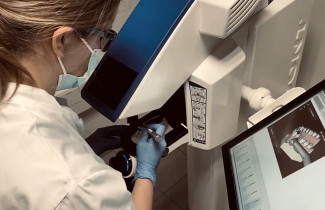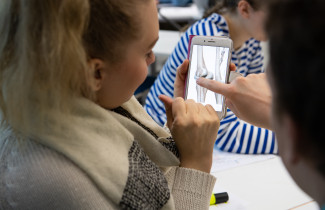The ADEE 2022 conference organised by the Association of Dental Education in Europe is a premier education conference that offers its attendees three days of immersive cross-border learning and dynamic networking – and helps to shape the future of dental education both on national and international levels.
Researchers of the Institute of Dentistry at UEF will present their novel findings about utilising the VR-haptic dental trainer as an additive preclinical teaching tool at the University of Eastern Finland, which has really revolutionised how drilling is taught for junior dental students. The team talk about learning from the greats, about the challenges of implementing VR-haptic training here at the Kuopio Campus, and about the importance of dental students’ self-activity today.
Is it a new trend to use VR-haptic training in dental education?
“Yes, VR-haptic technology provides opportunities for the development of new forms and systems of Dental Education as it is a wide-ranging change process, both for individual students and for us, educators, as an organisation. The Institute of Dentistry is using three Simodont® devices, the only ones in Finland, and we have actually done a special study that is going to be presented at the ADEE conference this summer, in 2022. The dental students and educators who participated in this pilot study found the insights of Simodont to be inspiring and confirmed that their use of the technologies would definitely continue,” Professor Liisa Suominen says.
"However, we have to see the benefits of Simodont applications in more detail, how we can use it with our dental students and educators. In practice, we still have a long way to go, as we need a solid foundation to underpin the use VR-haptic opportunities as part of our education. We should establish several VR-haptic-based training programmes on different dental courses offering students access to resources on different dental procedures in the near future,” Suominen continues.
“I think it’s very important to give students timely and constructive feedback. The hallmarks of a good educator’s comments are that they are on time, thorough, objective and critical, but helpful too. It should be clear to students from educators’ comments why they have decided to recommend the acceptance or rejection of an exercise. We know that dental students have typically worked hard to produce the best job they can and feel that they deserve constructive feedback. It’s perhaps worth mentioning that VR-haptic training can help in this context a lot, as well. Moreover, I am really excited about what Simodont and its applications can bring to dental hygienist education,” Suominen says.
What makes VR-haptic training a stand-out educational tool?
"When we started our projects in 2021, it was really exciting to see that dental students who were coming into the simulation room for the first time ever could benefit a lot after just a few sessions of using this VR-haptic technology regarding their dental vision and manual skill training,” Hanna Hytönen, an ADEE presenter, says.
What areas of research are you particularly excited to share in ADEE 2022? Can you briefly outline what that is all about?
“Of course, we also started carrying out evidence-based research immediately. The main research questions were:
- Can dental undergraduates, exploring and learning in virtual environments, improve their manual dexterity, increase their efficiency, and improve their working quality?
- Repetitio est mater studiorum (i.e., repetition is the mother of studying/learning) is a notable Latin phrase that indicates the importance of repeated practice in learning. How will the learning curve of students be influenced during the repeated VR-based haptic tasks, and will those enhance students’ skills?” Hytönen says.
“The results indicate that the Simodont dental trainer gave users the ability to exercise the drilling procedures freely, with a realistic look and feel of the drilling procedures. With just a click of a button, dental students were given several options on how to drill different subjects in VR, and more. Ninety-five percent of the first- and second-year dental undergraduates accessed the assigned voluntary free-time exercises. Simodont also allowed the students to see the level of their performance in action, making learning processes more interactive and informative. The overwhelming majority of students rated the implementation of digital aspects in their training as positive in terms of handling, didactic benefit, and motivation. It also offered a relaxed training scenario and gave preference to the assessment of the digital preparations: 96% of the students indicated that they could imagine using the haptic trainer during their studies in the future.”
“According to the students’ open-ended responses, the new haptic device played a positive role in enabling 24/7 independent learning and it helped the students perform the drilling exercise more accurately, improved confidence, and reduced the students’ mental workload due to risk-free practice. The descriptive summary of the Simodont readout indicates that VR-haptic training can help to attain the required fine motor skills for a target removal and significantly shortened students’ learning curve on a basic drilling procedure.”
“Hereby, we would like to thank junior dental students at UEF who personally contributed to this recent study. Without their generous giving of their time, energy, and perseverance, this project would not have been possible,” Hytönen concludes.
What sort of impact do you think Simodont will have in dental training?
“We believe this work might help launch a new era of VR-haptic dental training in tandem with traditional preclinical phantom-head simulations, and VR-haptic training will influence the transferability of acquired skills to the later clinical training situations,” Tiina Tuononen says.
What are the future topics you all are passionate about?
“There is still a wealth of research to be done on other interesting aspects, including assessing the educational benefits of this modality and developing appropriate metrics for it,” Professor Murat Mutluay notes.
To conclude our conversation, how would you describe your role in relation to the VR-haptic device junior dental students work with? Is there any advice you might want to give to junior dental students who wish to train with Simodont during their very early preclinical years?
"I see myself as a facilitator, a problem solver. I try to inspire students to do their very best and brainstorm as much as possible. I know well from my own work that training junior dental students’ manual skills can be one of the hardest things to manage. I would say that if students have extra free time,, they should try using Simodont to make its usefulness as high as they can. Revise. Clarify. Be patient and be steadfast – stick to it, even if the emotional experience of being failed by a VR-haptic exercise is still strong! But that is perfectly natural during students' early preclinical career. Therefore, I use to say that you just need to try to improve your contribution every time you are being asked to restart a procedure. Restarting is an opportunity to improve your skills with no risk when you use Simodont – it is revision for a good reason. Improving students' skills is what matters the most,” Szabolcs Felszeghy adds.







